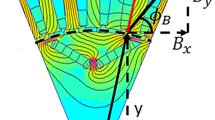Abstract
The air-gap of electro-magnetic (EM) actuators determines key operating parameters such as their ability to generate force. In haptic devices these parameters are not optimised for the conditions typically seen in operation and include the heat produced in the air-gap, the volume of the air-gap, and the intensity and direction of the magnetic field. The relationship between these parameters is complex thus design decisions are difficult to make. This paper considers the role of the radial magnetic field in cylindrical electric motors, a type often used in haptic devices. Two models are derived and compared with experimental measurements. The first model is a closed form solution, the second is a classic Poisson solution to Ampere’s equation. These models are shown to be valid for making more general design decisions in relation to haptic actuators, and in particular allow an evaluation of the trade off between the volume of the air-gap, the resulting radial magnetic field and hence heat generated and the resulting forces.
Access this chapter
Tax calculation will be finalised at checkout
Purchases are for personal use only
Similar content being viewed by others
References
Buckley, P., et al.: Effects of thermal protection methods on haptic perception. In: 2011 IEEE World Haptics Conference (WHC), pp. 143–148. IEEE (2011). https://doi.org/10.1109/WHC.2011.5945476
Carignan, C.R., Cleary, K.R.: Closed-loop force control for haptic simulation of virtual environments. In: haptics-e.org 1.2 (2000). http://www.haptics-e.org/Vol_01/index.html
Gosline, A.H.C., Hayward, V.: Dual-channel haptic synthesis of viscoelastic tissue properties using programmable eddy current brakes. Int. J. Robot. Res. 28(10), 1387–1399 (2009)
Harwin, W.S., et al.: Design and clinical potential of programmable mechanical impedance. Robotica 5, 523–530 (1998). ISSN 0263–5747. https://doi.org/10.1017/S026357479800068X
Jarman, R., Janko, B., Harwin, W.S.: Current overstressing small DC motors to evaluate performance limits of electrome chanical actuators for haptic applications. In: 2015 IEEE World Haptics Conference, pp. 171–176 (2015). https://doi.org/10.1109/WHC.2015.7177709
Mohand-Ousaid, A., et al.: Haptic interface transparency achieved through viscous coupling. Int. J. Robot. Res. 31(3), 319–329 (2012)
Rios, M., et al.: Thermal performance modeling of foil wound concentrated coils in electric machines. In: 2016 IEEE Energy Conversion Congress and Exposition (ECCE), pp. 1–8 (2016). https://doi.org/10.1109/ECCE.2016.7855512
Salon, S.J.: Finite Element Analysis of Electrical Machines. Springer, New York (1995). ISBN 978-0-7923-9594-2. http://books.google.co.uk/
Strang, G.: Computational Science and Engineering. Wellesley-Cambridge Press (2007)
Townsend, W.T., Salisbury, J.K.: The efficiency limit of belt and cable drives. J. Mech. Transmissions Autom. Des. 110(3), 303–307 (1988)
Townsend, W.T.: The effect of transmission design on force-controlled manipulator performance. Cable efficiency discussed in chapter x 67–77. Ph.D. thesis. MSME: MIT (1988). https://dspace.mit.edu/bitstream/handle/1721.1/6835/AITR-1054.pdf
Weir, D.W., Colgate, J.E., Peshkin, M.A.: Measuring and increasing Z-width with active electrical damping. In: Symposium on Haptic Interfaces for Virtual Environment and Teleoperator Systems, haptics 2008. IEEE, pp. 169–175 (2008)
Acknowledgements
With thanks to Peter Tolson and Mike Charij for assisting with the experiments and to Maxon motors for providing old stock motors.
Author information
Authors and Affiliations
Corresponding author
Editor information
Editors and Affiliations
Rights and permissions
Copyright information
© 2018 Springer International Publishing AG, part of Springer Nature
About this paper
Cite this paper
Harwin, W.S. (2018). Modelling the Air-Gap Field Strength of Electric Machines to Improve Performance of Haptic Mechanisms. In: Prattichizzo, D., Shinoda, H., Tan, H., Ruffaldi, E., Frisoli, A. (eds) Haptics: Science, Technology, and Applications. EuroHaptics 2018. Lecture Notes in Computer Science(), vol 10894. Springer, Cham. https://doi.org/10.1007/978-3-319-93399-3_9
Download citation
DOI: https://doi.org/10.1007/978-3-319-93399-3_9
Published:
Publisher Name: Springer, Cham
Print ISBN: 978-3-319-93398-6
Online ISBN: 978-3-319-93399-3
eBook Packages: Computer ScienceComputer Science (R0)



